Part 3: Analysing the cost of delivering services
The first part of the performance story
3.1
An entity measures the cost of its service delivery by assessing whether it is providing its goods and services economically and efficiently. Therefore, economy (the relationship between investment and inputs) and efficiency (the relationship between inputs and outputs) measures form the foundation of performance analysis. These measures are usually found in the SSPs in annual reports.
3.2
The SSP must:
- describe each class of outputs the public entity supplied during the financial year; and
- include, for each class of outputs:
- the standards of delivery performance the public entity achieved, compared to the standards included in its forecast SSP at the start of the financial year; and
- the actual revenue earned and output expenses incurred, compared to the expected revenue and proposed output expenses included in its forecast SSP at the start of the financial year.6
3.3
However, this reporting is not an end in itself, but the starting point for determining the performance story. It is the first component of the two essential parts of creating a true picture of an entity's performance.
3.4
Figure 3 illustrates this by shading the economy and efficiency measures.
Figure 3
Outcomes model, indicating areas of output reporting
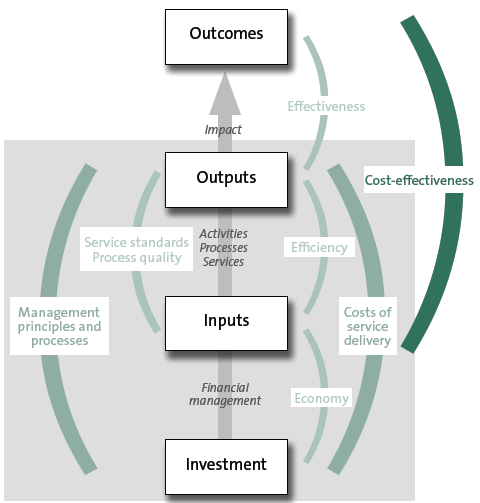
3.5
Output classes are groupings of similar outputs, which are used to enable the reader to make sense of the public entity's outputs without being overwhelmed with detail. All significant goods and services should be identified and reported on within an entity's output classes, to ensure that readers get a comprehensive, balanced, and proportionate picture of the public entity's services.
3.6
Determining the level and basis for aggregating performance information is a matter for judgement. In practice, many public entities' outputs classes are comprised of several individual outputs.
3.7
Outputs can be similar in a number of ways. For example, they could be grouped according to:
- the outcomes to which the outputs contribute – this can help a reader understand the extent of effort an entity directs to achieving its outcomes;
- the intended recipient of the service or the purpose to which the outputs contributes – this can help a reader understand, for entities with a range of different roles or functions, the extent of resources committed to carrying out each role or function;
- similarity in the nature of the outputs – this can help a reader to understand output efficiency, or the cost at which services are delivered.
3.8
To analyse performance and the cost-effectiveness of services, output class reporting needs to be based on a clear and justifiable rationale for aggregating the output information. The New Zealand Institute of Chartered Accountants Technical Practice Aid 9 Service Performance Reporting (TPA-9) advises that, as a general principle and just as for financial reporting, outputs should be aggregated according to their nature.
3.9
Depending on the basis used to comprise an output class, the key aspects of an entity's performance, effectiveness, and efficiency story may not be clear enough for a reader to understand and assess the costs and performance information of significant or differing individual outputs within an output class. Where this is the case, entities should provide more information, and break down the information to ensure that this story is set out.
3.10
Likewise, most entities report against their output revenue and expenses at the output class level as a whole, and do not break the information down into revenue and expenditure by outputs. Figure 4 sets out public entities' approach to reporting against outputs.
Figure 4
Public entities' usual approach to reporting against outputs
| Actual [prior year] $ |
Budget $ |
Actual [current year] $ |
|
|---|---|---|---|
| Revenue | |||
| Crown revenue | |||
| Other revenue | |||
| Total revenue | |||
| Expenses | |||
| Annual appropriation | |||
| Other appropriation | |||
| Total expenses | |||
| Net surplus/(deficit) |
3.11
The drawback of this approach is that one overall revenue and expenditure amount for each output class can make it difficult for the reader to understand the significant influences on output class revenue and expenditure results.
3.12
Public entities could be more consistent in how they structure and present the financial and non-financial information within the forecast and actual performance reports (such as output titles and descriptions). Such consistency ensures that readers can confidently put the right aspects of information together.
3.13
We consider that entities could improve their output reporting by:
- Providing breakdowns – Allocating revenue and costs to significant or differing individual outputs within each output class. This would increase the value of reporting by showing the cost of carrying out outputs, where the basis of output class aggregation would not otherwise allow service efficiency to be assessed.
- Using a consistent structure and description – Public entities should use consistent output classes, and output titles and descriptions, throughout their forecast information, including in their financial information. This links services and performance levels with their associated costs.
- Providing context – The reader will understand the results better if the entity provides contextual information about challenges and the entity's responses to them alongside the numbers. Commentary on the effects that the environment and the challenges have had on service levels, impacts, and outcomes provides a more rounded picture of performance. Historical information helps readers see trends. We cover the importance of trend data and analysis in more depth later.
- Having appropriate measures – The selected performance measures need to be appropriate and reflect the significant outputs provided. Measures should offer the greatest insight possible into critical aspects of the outputs and their delivery.
- Giving an honest appraisal – Whether it is good, bad, or indifferent, the reader wants to know what the entity makes of its own performance, and that it is managing performance as a result. We consider that public entities could do better than merely reporting "achieved" or "not achieved". Commentary explaining the performance result provides context for understanding how that performance result was arrived at and the entity's response.
Examples of output reporting
New Zealand Fire Service Commission
3.14
How the performance results are set out for reporting purposes is very important for providing an analysis of impacts and cost-effectiveness.
3.15
In its 2009/10 annual report, the New Zealand Fire Service Commission (the Fire Service), illustrates good practice in output reporting. Figure 5 shows how, for each of its three output classes, the Fire Service breaks its reporting of the revenue and expenditure performance measures down into significant individual outputs.
Figure 5
New Zealand Fire Service Commission - reporting of revenue and expenditure for output classes
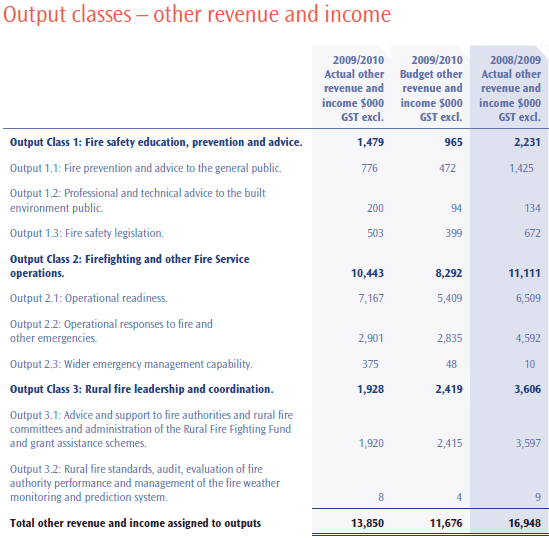
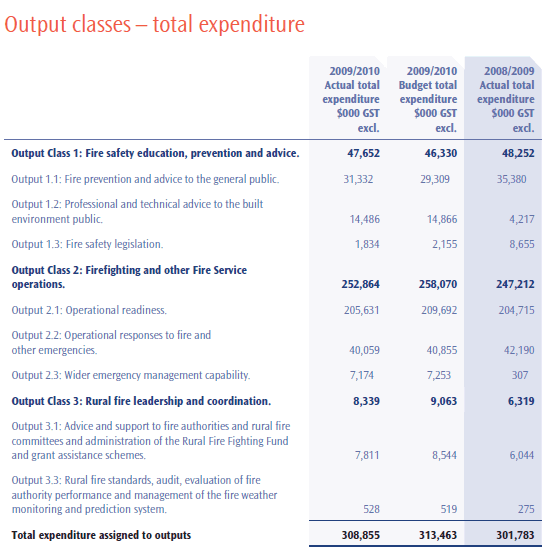
Source: New Zealand Fire Service Commission, Annual Report 2009/10, pages 36-37.
3.16
Figure 6 gives an example of how each significant output has the performance measure, target, actual result, and previous year's result as a comparison.
Figure 6
New Zealand Fire Service Commission - reporting of performance measures for significant outputs
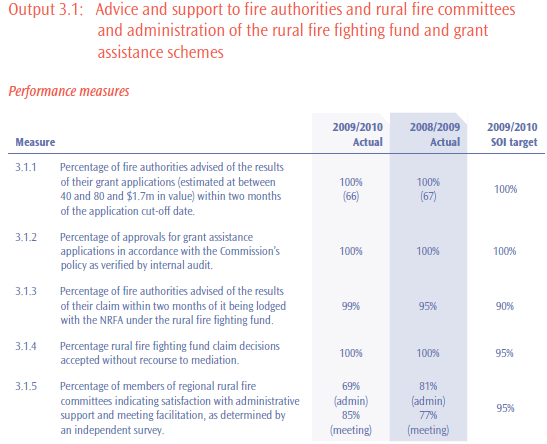
Source: New Zealand Fire Service Commission, Annual Report 2009/10, page 44.
3.17
Structuring and labelling data consistently in the financial and non-financial parts of the annual report aids clarity and analysis. Allocating revenue and expenditure to significant individual outputs means that the Fire Service has provided the basis for analysing its performance, including cost-effectiveness.
New Zealand Customs Service
3.18
The 2009/10 annual report of the New Zealand Customs Service (Customs) also illustrates good practice in output reporting. As Figure 7 shows, Customs includes commentary that provides contextual information and explains its achievements for the period.
Figure 7
New Zealand Customs Service - reporting of output classes
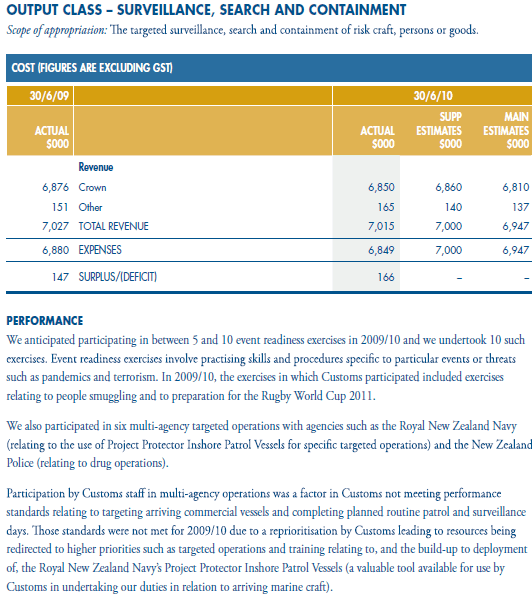
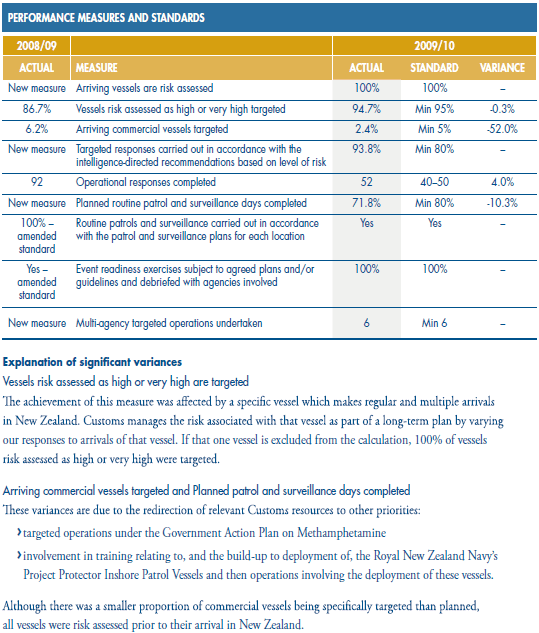
Source: New Zealand Customs Service, Annual Report 2009/10, pages 47-48.
3.19
In summary, public entities should use output reporting as the starting point for an in-depth performance analysis.
Conclusions on analysing the cost of service delivery
3.20
Outlining the cost of service delivery (through efficiency and economy measures) is the first step in producing a robust performance report. Readers need to know what was planned to be delivered, what was actually delivered, how much the outputs cost, and to what standard they were delivered.
3.21
Most public entities' annual reports tell readers how much a class of outputs cost to deliver. Although the PFA and the CEA require public entities to report performance based on classes of outputs, an entity can report at an output level if this provides better information to the reader. Revenue and expenditure can be allocated at an individual output level, and some entities are already reporting in this way. Also, reporting at an output level can reveal performance issues that reporting at the class of outputs level does not.
3.22
Public entities need to pay more attention to providing contextual and explanatory information about their results and achievements, whether or not they are favourable. Readers are too often left to draw their own conclusions because entities have not provided enough contextual or evaluative information about their performance.
3.23
In many cases, service delivery can be evaluated better if reporting is at a significant individual output level rather than at the class of output level. Although there is no legislative requirement to show reporting at the individual output level, it can increase the value of reporting by showing the cost of carrying out significant services.
| Recommendation 1 |
|---|
| We recommend that public entities structure the service performance and cost of service information to show the efficiency and economy aspects of performance. |
| Recommendation 2 |
| We recommend that public entities provide better analysis and evaluation of their achievements so that readers have a full picture of the entity's performance. |
6: Section 45A of the PFA. The CEA sets out similar requirements in section 153.
page top